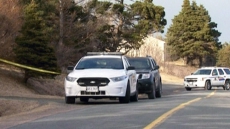FORT ST. JOHN, B.C. — Hundreds of people are allowed to return to their homes in northeastern British Columbia after encroaching wildfires forced them to pack up and leave several days ago.
Still, an evacuation alert remains in place for more than 17,000 residences in two regions north of Fort St. John, where crews continue to battle a pair of uncontained flareups.
Ryan Turcot of BC Wildfire Service said residents near the Siphon Creek and the Beatton Airport Road fires must be ready to leave at a moment's notice should conditions deteriorate.
"We are taking the current situation very seriously," Turcot told reporters on Sunday. "The BC Wildfire Service is certainly prepared for the worst and hoping for the best."
Cooler temperatures and some rain and snow have provided welcome assistance to firefighting efforts, allowing crews to build additional control lines and put out flames where appropriate.
There are currently 78 fires burning across British Columbia, with 52 in the province's northeast. The vast majority were caused by people, said Turcot, adding that "even one human-caused wildfire is one too many."
Well over 400 square kilometres of land in British Columbia has been burnt so far this season, which far surpasses the eight square kilometres consumed by this time last year, and the 10-year average of 14 square kilometres.

But an early and active start to the fire season doesn't necessarily mean the rest of the summer will follow the same trend, Turcot said.
"The first half of the summer we may see warmer and drier conditions on average, but it's really going to depend on the amount of precipitation we see in the late spring that's going to be a better indicator of how active the core of our wildfire season is."
The Siphon Creek fire, about 60 kilometres northeast of Fort St. John, jumped the border Thursday into disaster-stricken Alberta, which is already reeling from a catastrophic blaze that has so far displaced tens of thousands of residents around Fort McMurray and done billions of dollars in estimated damage.
Most of the 400-square-kilometre blaze remains in B.C. and it is expected to grow with a forecast return to hot and dry conditions this coming week.
The 150-square-kilometre Beatton Airport Road fire is located about 45 kilometres north of Fort St. John.
Fire officials are reminding the public that the use of unmanned aerial vehicles near active wildfires is prohibited after drones were spotted on two separate occasions.
"Violating these rules can put the lives of air crews (and) those on the ground in jeopardy," said fire information officer Emily Epp from the Prince George Fire Centre.
"When we have aircraft working on those fires it can ground our aircraft and that can severely hamper our progress on fire suppression."

So far this season, crews have responded to 224 wildfires, compared to 105 last year and an average of 146 over the past 10 years.




